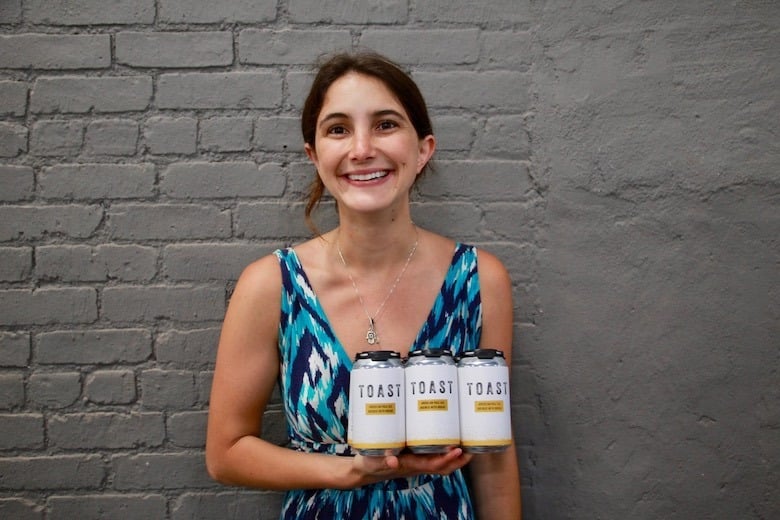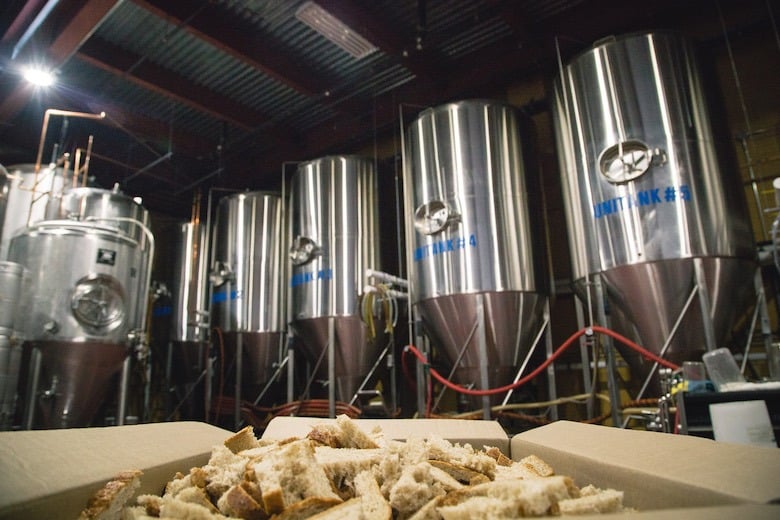Raising a Glass to Toast Ale with Madi Holtzman

Food and environmental justice advocate Madi Holtzman is director of the US branch of Toast Ale, a social enterprise that repurposes day-old bread that would otherwise be sent to landfills into America’s favorite fermented beverage: beer. With a background in community development, Madi says her relationship to food waste began when she was working at the Nashville Food Project, an organic urban farm in Tennessee that uses a combination of their crop and recovered foods to prepare and deliver 4,000 hot meals weekly to people experiencing hunger in Nashville. As Madi says, “I saw firsthand every day the mind-blowing quantity of nutritious food that was coming through our door that would have otherwise gone to waste, and the power of food to build community — through both gardens and sit-down meals.”
Madi has spent time in the fields as a farmer and in cities seeking food justice but dreams of getting her hands back in the soil. In the meantime, she is leading the heroic food waste charge by repurposing surplus into Toast Ale. We recently got a chance to talk about craft beers and sustainability with Madi.
Toast’s motto is that to save the world, we have to throw a better party than those destroying it.
Toast Ale has the remarkable quality of having tied together three things we love and hold dear here: bread, fighting food waste and beer. Tell us a little about Toast’s food waste model and about how Toast Ale operates.
Toast Ale has a multi-level approach to addressing food waste. The first is, of course, to save as much bread from landfills as possible by brewing it into delicious craft beer. Our mission globally is to save 100 tons of bread in our first three years. In addition to this, we will pour 100 percent of profits into our sister charity Feedback, which tackles the root causes of food waste through awareness campaigns, gleaning networks, research and policy recommendations. Finally, Toast aims to raise awareness about food waste and spark conversations around further innovative solutions.
What has the transition been like for Toast’s expansion into the US?
People have responded with the same enthusiasm to the Toast Ale concept in the US as they have in the UK, although the behind-the-scenes work that goes into starting a beer business in the US is shockingly more complicated than it seems to be elsewhere — thanks to a system still based on the aftermath of Prohibition. Our bread source is different too — in the UK, they primarily use loaf heels leftover from sandwich manufacturing. But in NYC, pre-prepared sandwiches are much less common. We have found wholesale bakeries to be the most common source of surplus bread by far.
Toast has seen a lot of popularity in the last few months, from articles in The New York Times to Mashable, to being featured at the Tribeca Film Festival. What is it you think consumers are responding to?
Toast’s motto is that to save the world, we have to throw a better party than those destroying it. I think that concept is exactly what people are responding to — Toast is a genuine solution to a very real and very serious problem, but it allows people to engage in a solution to this problem in a very celebratory way! We are all inundated with information about the many social and environmental problems facing our world, and we’re hungry for positive solutions. Or thirsty in this case!

Given your credentials as an all-around food waste champion, you’ve been hired as the sole employee to oversee the US side. How did you end up working for Toast and what is your day-to-day like?
Thomas McQuillan and Johanna Kolodny, the amazing folks who helped Baldor achieve zero food waste, are mentors and friends and are well-aware of my obsession with food waste. As such, they told me I must attend Feedback Global’s Feeding the 5000 event in Union Square last spring. Feedback is Toast Ale’s sister non-profit. Both organizations were founded by international food waste author and activist Tristram Stuart. I went to the event and was so inspired by Feedback’s work to reduce food waste globally that I sucked up the courage to introduce myself to Tristram. We instantly bonded over our food waste connection and when he mentioned Toast Ale and that he was just starting to consider bringing the enterprise to NYC, I knew I had to get involved. I was ironically trying to start a bread pudding social enterprise at that time for the very same purpose of saving surplus bread. I instantly recognized the infinite scalability of Toast Ale and am so grateful to have had the opportunity to bring this genius solution to life on this side of the pond.
And my day to day? That is basically impossible to answer as it is constantly changing! It ranges from coordinating media coverage at the brewery, to meeting with grocery store and restaurant owners, to organizing delivery logistics for all our ingredients and canning supplies, to calling the state liquor authority to ask a million questions. Lately, I’ve been working on making Toast Ale deliverable. Starting Friday, July 28th, Toast Ale will be available for purchase on FoodKick!
Let’s geek out for a minute and talk about ingredients. Brewing beer is a pretty finicky process. Is it difficult to maintain consistency when using bread rather than a more conventional malt? Are there adjustments that need to be made to compensate for that?
Believe it or not, the type of bread does not impact consistency nearly as much as most people imagine. We are primarily relying on the bread for the long-chain carbohydrates they lend to the brew, which we can count on from any and every type of bread. They actually did a test in the UK to prove this: they made one brew with conventional sandwich bread and another with artisanal loaves. A panel of brewers and chefs couldn’t distinguish between the two brews! The one complicated element of the process is that we need chunks of bread rather than full slices to maximize surface area and prevent the bread from clumping and jamming the mash tun. We are so lucky that our incredible NYC bread partner, Bread Alone, is so committed to the Toast Ale project that they help us process their surplus bread into the exact size pieces we need to brew.
How does the bread flavor affect the overall taste, and does that influence your choices with other ingredients, such as hops? Do you have plans for special brews with, say, pumpernickel?
The bread definitely lends a malty note and caramel tones to the beer. Our flagship beer in the US is an American Pale Ale. So our hop choice was actually based on the US-grown hops that are best suited to a delicious, craft pale ale. But we definitely have plans for special brews to play up the special characteristics of different types of bread. We plan to do some exciting collaboration brews with our favorite Northeast breweries this fall. I’ve had it in my mind forever that we need to do a chocolate babka stout.
Oh God, yes.

You’re currently using Bread Alone as your bread supply, but for your first New York batch, you visited a lot of bakeries to ask for bread. Did you come up against any resistance when asking for day-old bread?
Oh man! For our first batch, we were supposed to have 500 pounds of bread delivered from a wholesale bakery — they called us up that day and said a pig farmer had accidentally grabbed the stack of surplus that had been set aside from us. In a panic, we called tons of bakeries including Bread Alone, as well as Grandaisy, Eataly, Runner and Stone, Whole Foods and Orwasher’s. And every single one of them said: “Of course, come grab our surplus loaves once we close tonight.” That was a really heartening experience, and also a really solid testimony for the need for solutions like Toast Ale — a couple hours of phone calls and we had more than 500 pounds of surplus bread on our hands. And it wasn’t even day-old bread; it was day-fresh bread that just didn’t sell. It is the norm for bakeries big and small to produce more bread than they will sell in case they get a last minute-order.
Toast has been an amazing model for solving one stream of food waste (bread) and since its proceeds will benefit future food waste solutions, can have an even larger impact on further streams. Do you see innovative food entrepreneurship like Toast Ale as paving the way for large-scale food waste solutions, or will we need different paths to advocate for sustainability?
Honestly, I think we need it all. There is no silver bullet as the causes of food waste are complex and occur at every step of the supply chain. I think entrepreneurial solutions definitely have an important role to play in terms of both creating innovative uses for food that would otherwise go to waste, as well as raising awareness and interest in the issue of food waste itself. But we need it all: policy changes, behavioral changes at the home level, alternative solutions for wholesale and grocery surplus, on-farm gleaning networks and a cultural shift in expectations for perfect-looking food.
Ultimately, all of this needs to add up to create a fundamental shift in how we think about food production — there is currently a widespread sense of panic that we will not be able to sustain a rapidly growing population. But the reality is we currently grow enough food to feed a population of 11 to 12 billion, we just do not prioritize its equitable distribution. My hope is that all of these solutions will help move the needle, and quickly, towards treating food as something to be cherished as a human birthright rather than merely a consumer good.
Keep up with what’s happening with Toast Ale:
Twitter: @ToastAleUSA
Instagram: @ToastAleUSA
Facebook: Toast Ale USA
More Reading
Gamify your family’s food waste reduction
June 30, 2025
Can food recyclers help us tackle household food waste?
June 18, 2025
Do organic waste bans and composting programs really take a bite out of food waste?
March 17, 2025
What is Europe getting right about food waste in schools?
November 15, 2024
Municipal composting has increased, but what does that really mean?
May 16, 2024
6 upcycled food trends to watch
February 13, 2024
Food scholar Darra Goldstein on the culinary history of preservation
October 30, 2023
Candying is the sweetest way to prevent food waste
October 12, 2023
Colleges have high rates of food insecurity and food waste. Students are helping address both.
October 4, 2023
The FoodPrint Guide to Freezing
August 3, 2023
